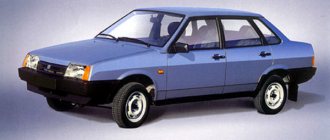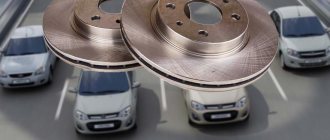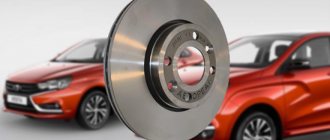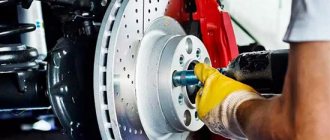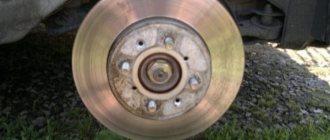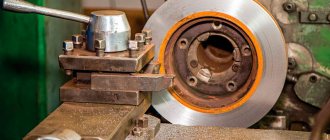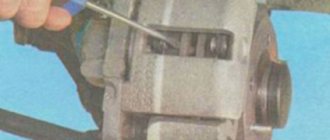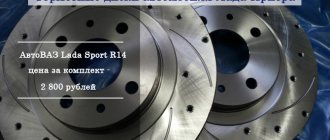Any vehicle, especially a high-speed passenger car, which poses a potential threat to life and health of both the driver and others, cannot be imagined without emergency stopping devices.
Such a mechanism is the braking system and maintaining it in working condition, primarily to ensure your own safety, is the direct responsibility of the owner of the “iron horse”.
How to tell if a brake disc is getting hot
Discs are one of the key elements of a vehicle’s braking system. They are usually made of cast iron and operate using a clamping mechanism, in conjunction with which there are also pads. When braking, the latter come into contact with the discs, slowing down the vehicle. At the same time, the disks heat up. In some cases they overheat. A driver with solid experience can determine this without difficulty. Beginners often do not pay attention to the “signals” that the car gives when the brake discs overheat.
Among the first symptoms of this problem:
- the appearance of sounds reminiscent of creaking or squeaking;
- The car does not pick up speed when driving in neutral downhill
- sudden increase in fuel consumption;
- rapid pad wear.
If you detect at least one of these signs, check the temperature in the area of the disks to confirm your suspicions. To do this, drive 300-400 meters, braking periodically. Stop and bring your hand to the disc area. Just don't touch it, otherwise you will get a severe burn. Normally, their temperature should be about 200-300°C. When overheated, it increases significantly, so you will feel the intense heat from the disks even at a distance.
If you don’t trust your feelings, use a special device to measure your temperature. It can be purchased at an auto store.
Experienced drivers can detect constant overheating even without instruments. All they have to do is inspect the discs, the color of which will tell a lot. So, at a constant temperature of 150-300 ° C, steel turns yellow. The wheels look like they are rusty and this scares many car enthusiasts. In fact, this is a normal reaction of steel to increased temperature. And 200-300°C when the braking system is operating is normal, so there is no need to worry. The blue or black color of the discs should alert you. They become like this with a “chronic” increase in temperature to 400-500°C.
If you suspect overheating of the discs, do not be too lazy to have the brake system diagnosed at a trusted car service center. Your life and that of other road users literally depends on its serviceability.
What system are we talking about?
Today, the braking system is quite effective thanks to the use of discs. They are a fairly significant element in this system, which means they are responsible for your safety. A disc brake operates using a clamping mechanism that includes pads. Brake pads are coated with a friction material, and when braking, they create friction with the disc.
With the help of this simple mechanism the car slows down. Brake discs are most often made of cast iron because it has low production costs and excellent friction properties. For sports cars, in order to reduce their weight and increase braking efficiency, discs made of ceramic and carbon fiber (carbon fiber) are used.
The dangers of overheating brake discs
A hot disk loses its main function. The pads slide along its surface and do not cling. As a result, the car becomes uncontrollable due to lack of proper braking.
In addition, temperatures above normal deform the disk. If even small drops of water get in contact with it, it can become cracked and even crumble.
Caliper cylinder piston jammed
In disc mechanisms there are no separate devices for removing pistons from the pads. The pressure in the hydraulic system is removed, the clamping force becomes zero, and the friction force is equal to the product of the pressure on the pad and the friction coefficient. That is, “zero” doesn’t matter what number it is – it will be “zero”.
But it doesn't always work out that way. The block should be retracted by a fraction of a millimeter at least due to the elasticity of the sealing collar. But if corrosion has occurred between the piston and the caliper cylinder, and the piston jams, the pads will remain pressed with non-zero force.
Energy release and uncontrolled heating will begin. It will end only after a certain thickness of the layer has been erased from the lining as a result of overheating and loss of properties. At the same time, the disk will overheat.
Why does the front brake disc get hot?
Both front and rear discs can overheat. However, it all depends on which wheels are driving and what type of braking system the vehicle has. So, on front-wheel drive cars, it is the front discs that overheat more often. A mixed braking system (front brakes are disc, rear brakes are drum) also causes overheating of the front discs. In both cases, it is the front axle that experiences increased load during braking.
There are several reasons for disk overheating. You can identify them yourself.
Driving style
Driving style leaves its mark on the condition of many vehicle systems, including the brake system. Aggressive driving, which means intense acceleration and sharp braking, leads to constant overheating of the discs. It turns out that they instantly heat up, but do not have time to cool down. This happens during relatively calm driving in the city during traffic jams and in extreme heat. In this case, try changing your driving style: start smoothly and brake smoothly. This will help reduce friction and, as a result, wear and overheating of the working surfaces of the disc and pads.
Brake fluid
Control its level. Lack of brake fluid leads to overheating of the discs. Its level in the tank should be between the maximum and minimum marks.
In general, brake fluid must be replaced every two years. Even if its level is normal, it loses its properties over time. Don't skimp on brake fluid; buy a quality product recommended for use by the car manufacturer.
Perhaps the problem is the newness?
As mentioned earlier, very often overheating of brake discs occurs immediately after replacing the pads. You can only find out when you brake hard - you should smell an unpleasant burning smell.
To prevent such situations you need:
- Degrease the friction surface of the discs, thereby getting rid of any remaining preservative lubricant;
- Clean the hub from possible debris. This does not mean the entire surface of the hub, but only the part to which the discs are attached. Use a stiff wire brush for this;
- Inspect all caliper pins for the presence of grease. It should be removed and a special lubricant applied instead. If this is not done, then the risk of jamming of the caliper structure increases.
Cleaning the disc surface and brake caliper pins
What to do if brake discs get hot
The solution to the problem depends on the cause of its occurrence. Sometimes simply changing your driving style is enough. In most cases, you cannot do without the help of professionals. The technicians will conduct diagnostics to identify the real cause and, if necessary, carry out repair work.
There are preventative measures that will minimize the risk of pads overheating:
- Replace pads and discs in a timely manner;
- purchase only certified spare parts;
- control the brake fluid level and replace it with a high-quality analogue;
- watch the thickness of the discs.
There are cases when, even if all the causes are eliminated, the front discs still continue to overheat. This is typical for a car with “mixed” brakes. In this case, many drivers take a drastic step - they install discs instead of drums on the rear axle. Then the braking load is distributed evenly across the axles. As a result, the front discs stop overheating.
The process of braking a car is based on the force of friction and cannot but be accompanied by the release of heat. The brakes constantly heat up and cool down. On modern cars, brake discs can be installed not only on the front, but also on the rear axles. Disc brakes are more efficient than drum brakes, easier to maintain and more reliable.
The principle of operation of such a brake is the pressure of the piston (6) on one of the brake pads (4), which begins to rub against the disc. The second block presses on it automatically by the caliper body, which moves along the guides (10). The pads on both sides begin to compress the disk - as a result, the rotation of the wheels slows down.
Of course, heat is generated. The temperature of disc brakes during intensive driving reaches 250-300°C. For sports cars, they are made of ceramics that can withstand heat up to 1000°C without deformation. But they do not go on mass sale due to their high cost.
Why does heating occur after replacing pads?
After replacing the pads, the wheels often start to heat up. This is not at all related to emergency braking, aggressive driving, or driving at high speed. At the same time, the car owner changed the part a few days ago. In such a situation, the reasons for disk overheating may be the following:
- low quality brake fluid;
- problems with electronics (occur in Toyota , Hyundai Solaris , Volkswagen Passat );
- brake caliper (an eternal problem with Renault, Lada );
- use of low-quality pads;
- clutch malfunctions (often observed in Niva, VAZ 2114 );
- VUT breakdowns (frequent in Skoda Octavia ).
These problems can be easily solved by using better quality auto parts, changing the oil, or calling a car service center.
Why do brake discs get hot?
Heating is not a malfunction if it occurs evenly on both sides and the temperature value does not exceed acceptable limits. In this article, by the word “heat” we mean overheating.
Most discs are made from cast iron. This metal is suitable for daily use - it is inexpensive and has good frictional properties. But it also has disadvantages: due to frequent braking, the cast iron gets very hot, even to the point of smoke. The pads begin to melt and warp.
Types
Standard discs for many car brands are made of cast iron.
This is explained by its good friction properties and inexpensive cost. But these parts made of cast iron have a number of disadvantages. With frequent braking, they begin to heat up greatly, up to several hundred degrees, which can cause smoke to appear when the friction layer of the pads melts and warping of the pads themselves.
And if water gets on their overheated surface to such an extent, then they can simply crack.
To reduce overheating, they began to produce ventilated discs with machined voids inside.
But this did not radically change their characteristics. Therefore, manufacturers became concerned about replacing them and began producing new perforated and slotted products made from steel alloys. In the first, additional ventilation is provided by many small holes along the entire diameter.
And the second ones have grooves machined on both sides.
After replacing standard ones with perforated or slotted disks, they begin to heat up significantly less. And everyone who replaced the standard cast-iron brake elements with slotted or perforated ones immediately felt the difference.
Attention! Under no circumstances should you make ventilation holes in standard cast iron brake discs yourself! They are not designed for this and may simply crack!
Why do brake discs get hot?
The principle of its operation is based on an attempt to “put spokes in the wheels to stop the cart”, only in our case these are brake linings, which on both sides compress the brake disc rotating with the wheel and, due to friction, stop it.
The energy released during friction and then absorbed by the discs is the reason for their heating - this is the result of a normal, working function.
When braking, they heat up quickly, but cool down more slowly, but with the expectation that the brakes will have time to cool down before the next press. Unfortunately, with frequent use of the brakes in the city cycle, and even in hot weather, this does not happen, which leads to their overheating.
The main reason for overheating is driving style. Aggressive driving, with sharp accelerations and hard braking, does not allow the brakes to cool down, and this ultimately leads to rapid wear of the brake system elements.
Moreover, the front brake discs heat up more, this is explained by their greater workload, due to the fact that the front of the car is always heavier than the rear. This effect is enhanced by the installation of drum brakes on the rear axle of the car, whose operating efficiency is lower, so the front discs are forced to take on their shortcomings. Malfunctions of the brake system, in which the linings constantly rub against the surface of the discs, are also the reasons for their overheating.
New pads made from low-quality materials also become a source of intense heat. To increase wear resistance, handicraft manufacturers add metal shavings to the friction mixture of the pads, which is what causes the temperature to rise.
What causes overheating?
Initially, I would like to note that the main reason for the heating of brake discs is friction - the main function they perform. As a result of friction between the surface of the disc and pad, the temperature immediately rises, but it takes much longer to cool down.
Remember how many traffic lights you encounter on the way to work and the distance between them. Think for a second, is there enough time between stops for the disk to cool down? Of course not, hence the overheating.
Driving style is a factor that cannot be overlooked. Each driver is unique in his own way and this uniqueness is reflected in his driving style. It follows that more aggressive and extreme driving leads to the fact that the brake discs will almost always be heated to a high temperature.
Another reason is the failure of any elements of the braking system. For the most part, this reason can be placed on a par with driving style, since the driver directly affects the performance of the system (proper care, timely maintenance, and so on).
The main reasons for overheating of brake discs
Let us consider in more detail the reasons for overheating of brake discs associated with malfunctions of the braking system:
- deformation (change in shape) of the brake disc;
- reducing the thickness of the friction part of the brake pads or the working surface of the disc;
- poor quality of parts;
- rear drum brakes. The presence of such a mixed system directs the bulk of the load to the front axle, because the drum brake is not able to fully perform its task.
What is the normal temperature when the brake disc is operating?
The thermal conductivity of steel and alloy cast iron, from which brake discs are made, allows them to be maintained in working condition only when heated to temperatures in the range of +200 – 300˚С; further overheating can, at best, lead to the formation of a scalding film on the disc, worsening the coefficient friction, and in the worst case – to sticking of the linings or warping of the disc itself.
By the color of its surface you can determine how powerful the temperature effect was on it:
- at +150-280˚С it turns yellow and this is the norm;
- from a temperature of +300-450˚С – turns blue;
- +450-500˚С cause it to turn black, which should seriously alert the driver.
Basic disk requirements
For security purposes, disks must meet the basic requirements that apply to them:
- Stability of characteristics when heated.
- Not responding to heatstroke.
- Resistance to adhesion (low adhesion threshold).
- Quite high thermal conductivity of the material from which it is made.
- High coefficient of friction and strength.
If the product does not meet these requirements, the possibility of the car getting into an accident increases significantly.
How the malfunction manifests itself
The malfunction, which results in intense heating of the brake disc, manifests itself as a characteristic metallic squeak from friction between metals. As a rule, one brake pad begins to jam, so the brake disc on one side overheats.
Curvature of the front discs, since they are the ones that most often suffer from such a defect, is accompanied, in addition to overheating, by a beating in the steering wheel when driving.
Severe wear of linings and discs (below the minimum permissible values) is manifested in a deterioration in their braking qualities and an increase in the distance required to stop the car. In addition, it may be accompanied by a squeak from the contact of the metal part of the pad with the disc shoulder and a decrease in the level of brake fluid in the master cylinder reservoir.
Hub problems
After eliminating natural causes of wheel overheating and problems with the brake system, all that remains is to check the hubs. Absolutely all possible problems of this unit are diagnosed on our own in the garage.
Here is a short list of possible problems with the hubs that cause the wheels to heat up:
- jamming of guide supports;
- critical wear of wheel bearings;
- lack of lubrication in wheel bearings;
- The tightening torque was not observed when repairing the hub.
Literally in a nutshell on every problem.
The caliper guides are jammed
Where there are anthers, dust will appear over time
Most often, caliper guides jam due to clogging or corrosion. Natural wear and tear of parts is also possible. After hitting a good hole, deformations of the guides occur. To diagnose this breakdown, the wheel of interest is hung on a jack, removed, after which the unit is inspected. If no signs of wear are visible, then most likely the damage can be eliminated by washing and lubricating the parts. If worn, replace.
Wheel bearing worn out
Most often, worn wheel bearings show themselves as wobbling and vibrations,
rather than heating the rims
When wheel bearings wear out, the rotation axis of the wheels is disrupted, causing the parts to be subject to parasitic friction and heat. Later, the breakdown manifests itself in instability of the car, and usually ends with terrible wobbling from side to side or the wheels jamming tightly. Vibrations and beating of the steering wheel are also possible. Wheel bearings cannot be repaired. Complete replacement only. Preferably on both sides on the same axis.
To identify wheel bearing wear, hang the wheel on a jack and, without removing it, rock it along the car's axle, grasping the top and bottom of the tire. If there is noticeable play, the bearing is either worn out or not tightened enough.
The wheel bearing has run out of grease
Most often, the grease in wheel bearings quickly burns out due to the fact that the hub overheats. And it starts to do this because wear has occurred or the lubricant has burned out. Almost a vicious circle, which, when one of the problems occurs, closes within a few kilometers. As a rule, this problem is not detected in a timely manner, therefore, the lack of lubrication leads to wear of the bearings. Replacement again.
The wheel bearing will be retightened during repair
This often happens when a car is repaired with your own hands or at a service station by inexperienced craftsmen. For each vehicle, the manufacturer prescribes its own hub tightening torque, which must be observed. Overtightened bearings quickly overheat (the wheels along with them), the lubricant burns out or evaporates, and everything ends in a wedge or critical wear.
How to prevent overheating
In order to prevent the brakes from overheating, the main contribution is, of course, made by manufacturers, using the most heat-conducting materials for their manufacture and developing ventilated structures in which the brake discs consist of two parts, with a special fan built between them.
The design of the brake disc itself, capable of self-cleaning from dirt and being ventilated by oncoming flow, is considered one of the most successful design discoveries.
In order to prevent overheating of the brakes during operation, it is necessary, first of all, to maintain the brake system in working condition, and for this you need to regularly check:
- brake fluid level in the master cylinder reservoir;
- brake disc thickness;
- brake pad wear.
Mechanical causes of disk heating
The malfunction of the brakes, or rather such an inconvenient defect as an increase in temperature, may also depend on individual parts of the brake system: the quality and quantity of the brake fluid (BF), the thickness of the brake pads and the condition of the surface of the disc itself. The amount of fuel fluid can be checked by the level in the barrel, which is usually located on the right under the hood. Its level must be between the minimum and maximum marks.
The thickness of the pads is regulated in the documentation for the car, in fact, as is the thickness of the discs. It is believed that even a few millimeters below the norm puts you at risk, firstly, this makes it easier for the disc to change its shape when heated, and secondly, it can simply burst at the moment of sudden braking. Overheating naturally becomes more significant and occurs faster when the thickness of the metal decreases. And the imperfection of the surface, i.e. various irregularities also increase the likelihood of overheating due to increased friction in places of defects.
According to the regulations, brake fluid must be changed every 2 years, regardless of the vehicle’s mileage. Brake pads depend on the driving style, but, on average, after 15-20 thousand kilometers. As they wear out, the brake discs also change.
You can avoid heating by replacing standard disks with ventilated ones. The ventilated version is a little more complicated than the usual one, but due to its design it cools faster. A disc brake of this kind consists of two plates approximately 5 millimeters thick, between which there are special air channels. Also, as mentioned earlier, a lot of heating can be avoided by driving quietly.
Useful tips
The fact that the brake elements are overheating is far from the most pleasant news for the car owner.
- Avoid any contact of water with the calipers. Do not drive aggressively in wet or rainy weather.
- Particular attention should be paid to washing. Wait a while for your discs to cool down. If water gets on hot metal, deformation cannot be avoided. In this case, only complete replacement of the disks will save you. Moreover, they are changed in pairs (just like the pads), even if the adjacent one is in good condition.
- Follow the instructions for replacing pads. Don't wait until they wear down to metal. This will cause deformation and increased heating of the disk.
Consequences of using the handbrake
The simplest thing that almost all novice drivers encounter is forgetting to release the parking brake when starting to drive.
Engineers have been successfully fighting this forgetfulness for a long time. Light and sound alarms have appeared that are triggered when an attempt is made to move when the brake pads are tightened, as well as automatic handbrake controls that are cocked and released by an electric drive when stopping the car and starting off.
But if you still drive with the pads pressed, the significant transmitted power will heat the drums so much that the pad linings will char, the metal will deform, and the hydraulic cylinders will leak.
This is often noticed only when the tires on the rims begin to smoke. Extensive and expensive repairs will be required.
Causes of overheating
There is a very big difference between heating and overheating. Heating is a normal phenomenon, that is, calculated and tested by the car’s developers, and overheating is an emergency.
Something went wrong, the temperature rose critically. In the case of brakes, this is very dangerous, since overheated parts cannot work normally and very quickly lose strength, geometry and service life.
Find out more about the new Logan
- When you turn the steering wheel, you hear squeaks in the Renault Logan front suspension
- Car suspension device Logan
- Renault Logan washer engine
- Coordination unit for towbar electrics
- Renault Logan in Saratov - prices, photos, specifications and configurations -
- Avtomir - official car dealer in Moscow
- Removing and installing the Renault Logan license plate light: step-by-step instructions
- The Renault Logan airbag light is on, how to fix it? – Taxi Bolt
Car owners' opinions on front wheel heating
- Stuck pad “I discovered by chance that the pads on the front wheel were getting hot. I contacted the official service. The diagnostic result stated that the block was stuck on the inside. They suggested doing preventive measures. As a result, the pads were swapped, lubricated and cleaned.”
- Check the lube!
“If the front left wheel gets hot, the reason is most likely a stuck brake cylinder. This happens after installing new pads. I came across this on Kalina. I had to change the wheel bearing. The old one lost its functionality due to overheating and leakage of lubricant. It can be eliminated by pumping a few milliliters of brake fluid under the cylinder boot using a syringe. Then the cylinder will be driven back and forth several times without pads. It’s easy to determine the need to bleed the cylinder: if it’s pressed tightly into the caliper, it means it needs to be lubricated.” - You need to wait
“It is likely that the pads or brake cylinder are jamming. In the situation immediately after replacing them, this sometimes happens. We need to wait a little while the details work in.”

